Discover over 150 creator economy statistics and trends to inform your creation efforts. We cover growth, engagement, monetization, and more.
Key takeaways
- The creator economy more than doubled to $250 billion in 2024 and could reach half a trillion dollars by 2027.
- Small creators thrive: 99% have fewer than 1 million followers yet successfully monetize content with a median of 4,000 followers.
- Creator content drives real business results, with 87% of consumers discovering new brands and 72% making repeat purchases.
Economic activity resulting from creating and sharing content online—otherwise known as the creator economy—has exploded in recent years, opening up a wealth of opportunities for creators to monetize their skills.
With economists projecting that the creator economy could be worth half a trillion dollars by 2027, there’s never been a better time to understand what makes this booming industry tick. That’s why we've consulted a range of sources to bring you over 150 creator economy statistics for 2026 and beyond.
Read on to discover key insights covering creator economy growth, monetization, trends, and more.
Creator economy growth statistics
The start of the creator economy can be traced back to the late 1990s when the first creators uploaded their creations to online communities and budding social media platforms.
As of 2024, the creator economy was worth over $250 billion1, up from an estimated market size of $100 billion2 in 2023.
The creator economy has evolved to include social media and many other submarkets such as:
- Ecommerce - worth $15.7 billion
- Education - worth $5 billion
- Ad-based video - worth $30.4 billion
- Esports - worth $6.9 billion
- Podcasts - worth $4.2 billion
- The Metaverse - worth $3.3 billion
- Video Games - worth $1.5 billion
- Publishing - worth $300 million
Globally, startups in the creator economy raised over $767 million between 2023 and 2024, marking a 49% year-over-year growth3.
In the US alone, creator economy startups secured over $692 million of funding in Q2 2024, over double the amount raised in Q1 2024 and a 68% increase from the same period last year.
Overall, in Q2 2024, AI startups within the creator economy raised the most funding at over $300 million, followed by those in Music and Shopping.
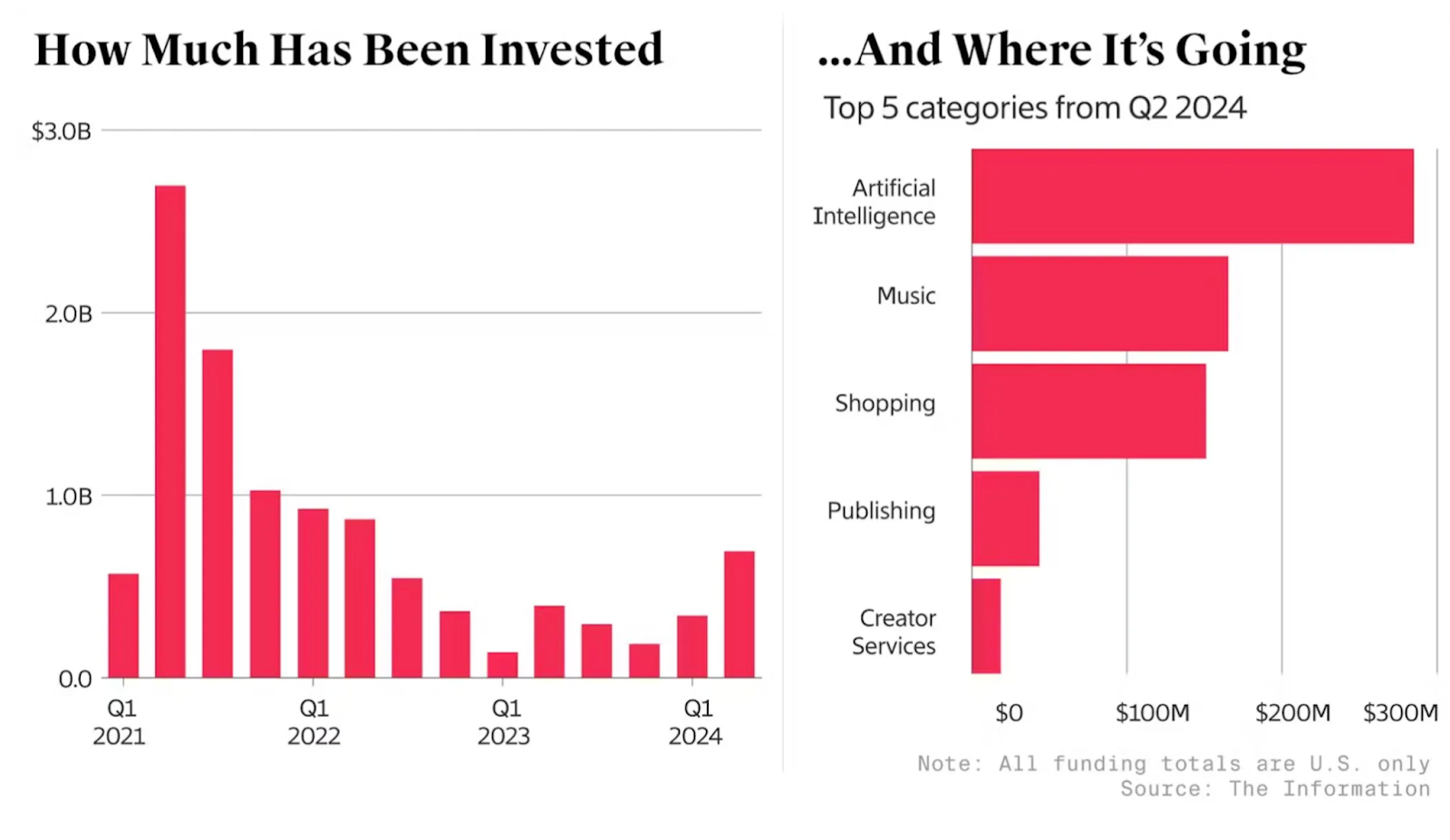
Between 2023 and 2024, Google searches for creator economy jobs surged by over 200%4.
Creator economy jobs increased by 66% between the first and second quarters of 2024.
In addition:
- Players in the creator economy primarily looked to fill mid-level (45%), experienced (21%), and management roles.
- Engineering roles were the most in-demand (29%), followed by sales roles(16.8%) and marketing (10.6%).
- The US was home to the highest number of creator economy jobs (29%), followed by the UK and Canada.
Creators in the creator economy statistics
Global research compiled by Adobe pegged the number of global creators at around 303 million in 20225.
The report found that as many as 1 in 4 people or 25% of people across the countries they surveyed were creators.
Key creator hotspots included:
- Brazil where 106 million creators accounted for 50% of the population.
- South Korea where 17.5 million creators accounted for 34% of the population.
- Spain where 17 million creators accounted for 36% of the population.
- The US where 86 million creators accounted for 26% of the population.
- The UK where 16.6 million creators accounted for 25% of the population.
On average, 60% of global creators had full-time jobs.
Around 20% of creators owned their own content-related businesses, with the US (26%), UK (24%) and Australia (21%) registering the highest share of creator business owners.
14% of all global creators were influencers.
Influencer creators were more prevalent in markets like Brazil (19%), Australia(19%), UK (17%) and the US(16%).
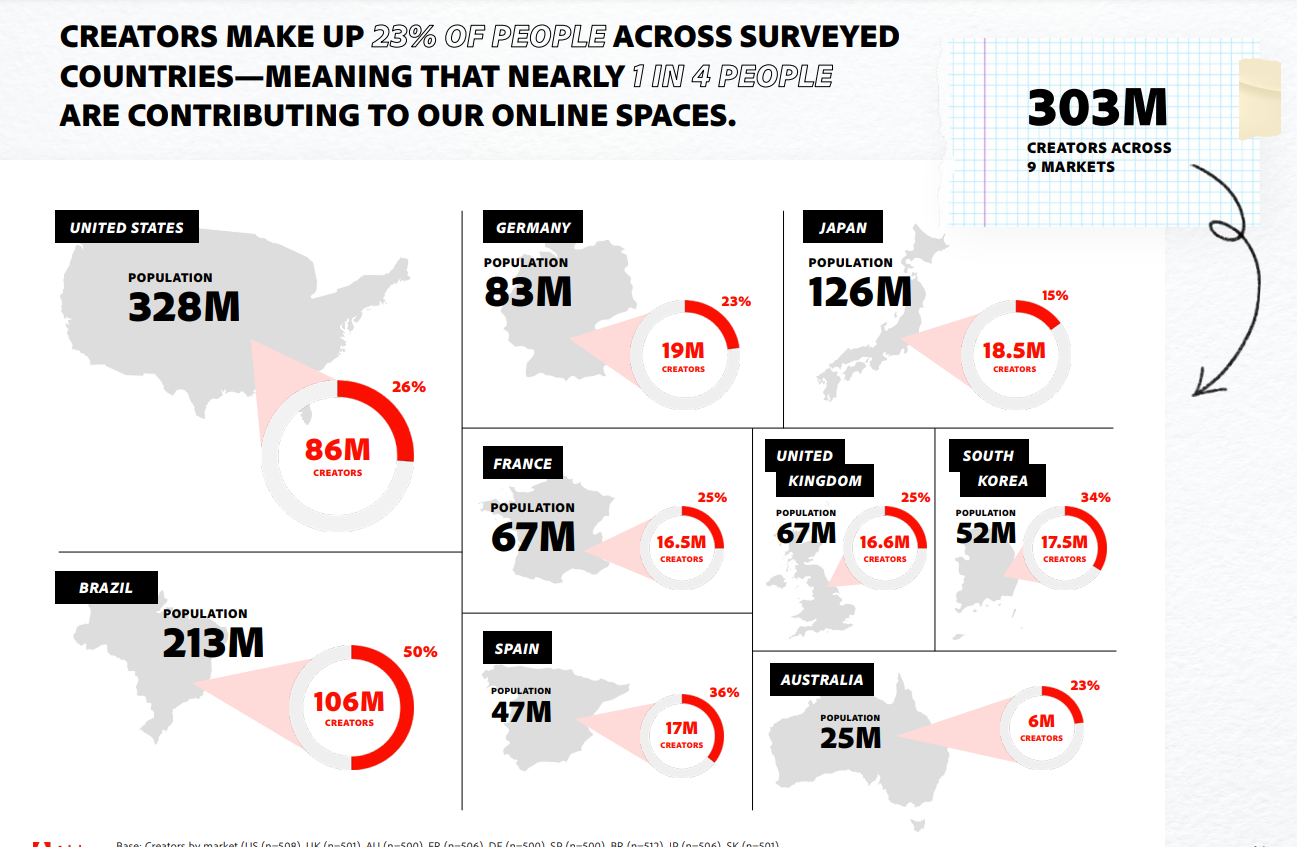
The top 10 most common creator types in 20236 were:
- Entrepreneur - 23%
- Blogger - 21%
- Coach -19%
- Educator -18%
- Writer - 13%
- Author - 9%
- Artist - 9%
- Marketer - 9%
- YouTuber - 6%
- Designer - 6%
Content creators with massive audiences (1 million+) made up 1% of the creator world7.
The other 99% of creators had a median of 4000 followers and made a full-time living by monetizing content.
Breaking it down further:
- 70% or 139 million creators were Semi-Pros with 1,000-10,000 followers6.
- 21% or 41 million creators were Pros with 10,000-100,000 followers.
- 12% or 23 million creators were Recreational with 0-1,000 followers.
- 1% or 2 million creators were Experts with 100,000-1 million followers
- 1% or 2 million creators were Expert + with over 1 million followers.
Over 50% of creators used their savings to start and grow their ventures.
- Over 40% funded their businesses using disposable income from another job.
- Just over 20% funded their businesses through credit cards or loans.
- Over 10% received start-up funds from friends and family.
- A small percentage (less than 1%) worked with VCs to find their businesses.
On average in 2023, creators needed around $10,700 seed money to launch.
They also spent $1,000 to $2,000 on their tech expenses annually.
Creator Demographics Statistics
As per a 2024 report, creator age demographics skewed Millenial and Gen X8.
- 41% of creators were Gen X
- 35% of creators were Millennials
- 14% were Gen Z
- 9% were Boomers
Creators tended to be younger and skewed male, with 63% being 40 or younger and 53% being male9.
This was consistent with 2022 findings by Adobe which found that over 40% of creators globally were Millennials, with 52% being male.
Baby Boomer and Gen X creators increased from 27% in 2022 to 35% in 2023. Also, 70% of creators worked part-time in the creator economy while 30% worked full-time.
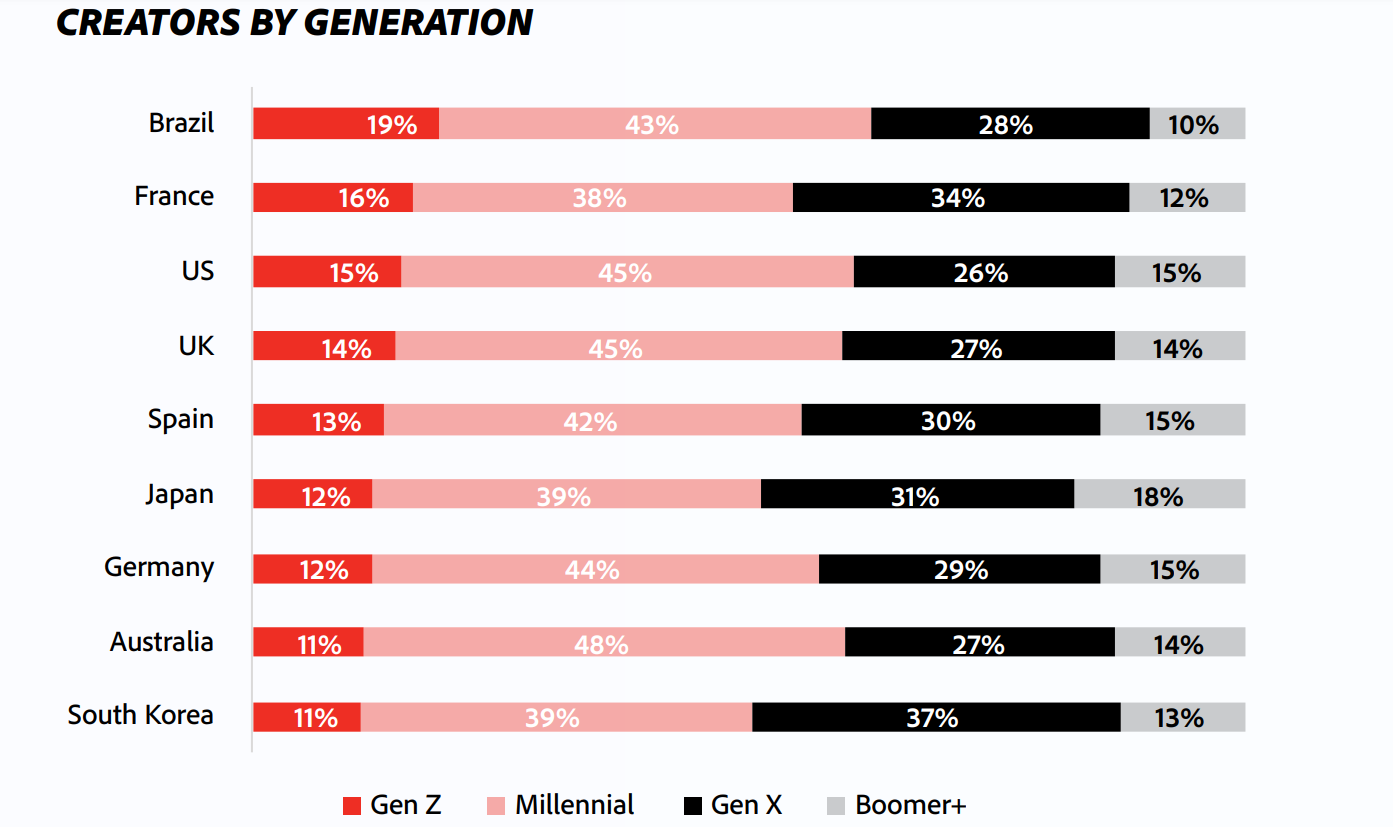
Online influencer was the top career choice of Gen Z with 57% selecting it as their profession of choice.
Gen Z creators are expected to increase as they age into the workforce.
Creator aspirations differed by gender, with 42% of women wanting to be solo creators compared to 34% of men.
However, more men 15% had goals to turn their creator ventures into larger businesses, compared to 7% of women.
Creator Sentiments Statistics
Over 32% of creators cited independence as the main perk of being a creator.
Creators also valued:
- Enjoying their work - 15%
- Pursuing their passions-14%
- Flexible work hours - 13%
- Earning more money - 6%
32% of creators were satisfied with how much money they made as creators.
Only 2% regretted their decision to become a creator.
When asked about the most profitable business strategy, the majority of creators (59%) selected consulting and coaching.
This was followed by:
- Online courses and workshops at 6.8%
- Affiliate marketing/links - 3.6%
- Speaking fees - 3.6%
- Sponsored content - 3.2%
The digital products that generated the most revenue for creators in the period between 2022 and 2023 were:
- Online courses - 70%
- Digital downloads - 63%
- Subscriptions and memberships - 57%
- Online consulting and coaching - 57%
As of 2023, 95% of creators believed that business skills were just as important as creative skills to be successful.
In addition, 86% of creators saw themselves as entrepreneurs.
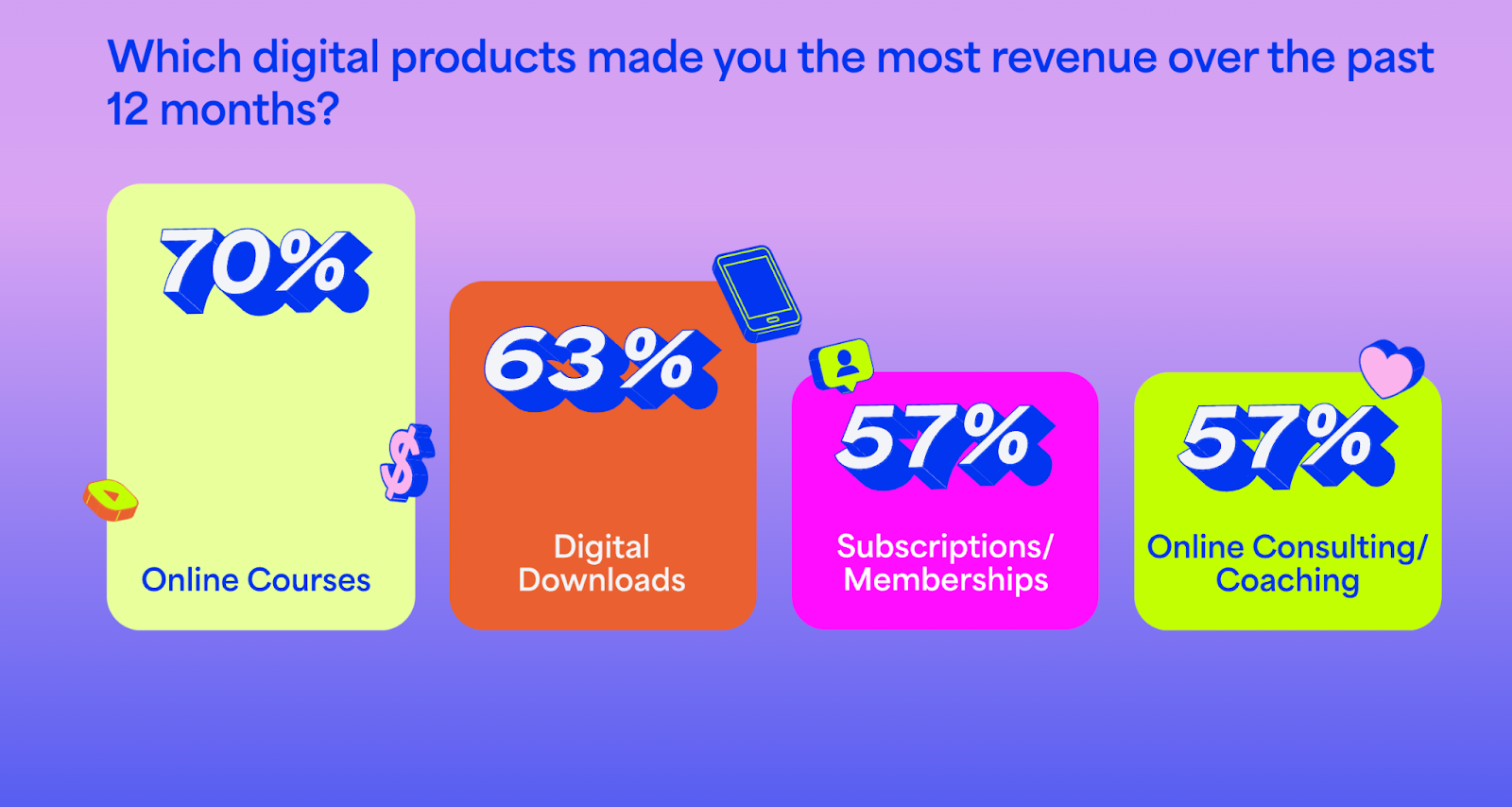
81% of creators invested in digital marketing analytics and other business-related skills to strengthen their careers10.
28% took on additional roles in their content creation businesses to deal with changing industry demands.
When collaborating with brands, 51% of creators cited brand values and alignment with personal beliefs as a crucial factor.
49% of creators cited the importance of creative freedom and control over their content. Meanwhile:
- 47% emphasized the importance of the quality of the brand's products or services.
- 42% prioritized compensation and monetary benefits.
- 39% valued the opportunity for exposure and greater audience reach.
Creators were ambitious about their revenue potential with 75% of creators stating that they believed they would make more than $50,000 annually in the next year.
- Additionally, the research found that the average creator used 3 platforms to generate income.
- While most relied on brand sponsorships, 83% wanted multiple revenue streams to include brands, platforms, and followers.
95% of creators took action to advance or support causes or issues important to them.
Social causes were top of mind for creators, with creators more likely to view food/housing security (57%), social justice (55%), and climate change (54%) as important.
Creator Content Statistics
As of 2024, a majority of content creators (58%) crafted emails or newsletters, followed by articles, blog posts, and books (51%).
30% of creators created educational courses and at 23%, short-form videos were the least popular type of content.
75% of creators chose to create video content in 2024.
Meanwhile, over 51% created visual content, 48% created written content and 42% created audio content.
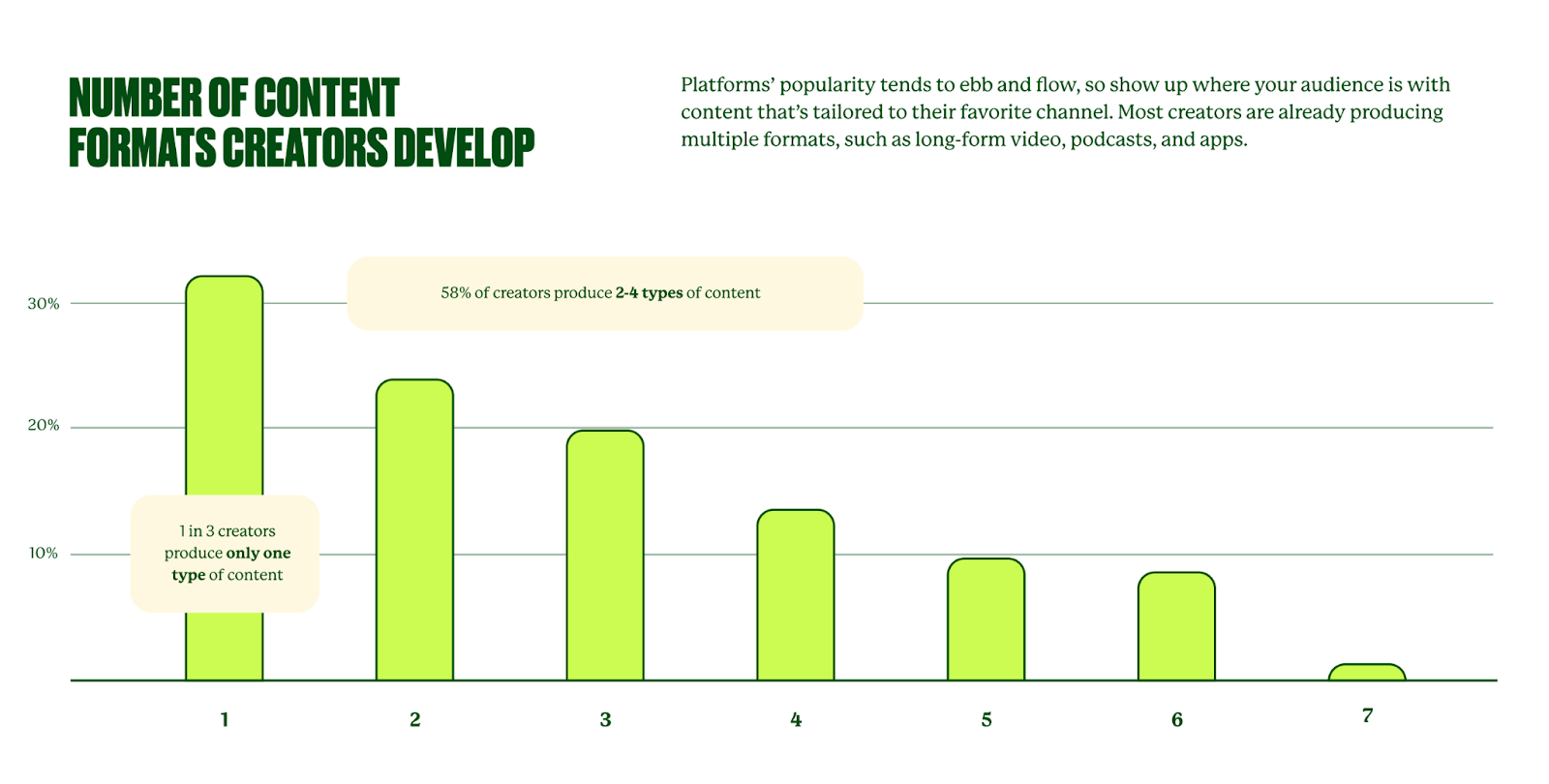
The most common types of sponsored posts creators offered were Instagram Feed posts and Stories (98%)11.
This was followed by:
- Instagram Reels - 98%
- TikTok Videos - 89.6%
- Instagram live - 69%
Creators spent over 45% of their time creating content each week.
- 20% of their time was allocated to content distribution and promotion.
- 16% of their time was spent on marketing and sales.
- 14% of their time was spent on business administration and operations.
The majority of creators (27%) covered topics related to business and entrepreneurship.
This was followed by personal development (18%) and
- Health and Wellness - 14%
- Marketing and branding - 14%
- Content Creation - 12%
- Arts and crafts - 12%
Creator economy engagement statistics
39% of consumers watched more creator content in 2023.
This is compared to just 22% watching more studio content. Additionally, creator content was more likely to drive consumers to search for additional content about a topic and interact with content by liking, commenting, or subscribing.
Creator content drove action throughout the entire consumer purchase journey. In fact, after being served creator content, 87% of consumers discovered a new brand, product, or service.
In addition:
- 81% received what they considered objective information from a real person.
- 70% decided what to buy faster.
- 72% made repeat purchases.
- 68% actively recommended the brand or product to others.
77% of consumers followed creators out of shared interests or hobbies or a desire to learn something new13.
- 33% of consumers followed creators because those creators were part of a community they identified with.
- 63% of consumers spent more time on platforms because of their favorite creators.
- Additionally, 50% of consumers sought out more creators because of their favorite creators.
Gen Z consumers followed a median of 10 creators and sought out these creators for new content and updates more than any other age group.
Millennials followed a median of 5 creators while Gen X and Baby Boomers each followed a median of 3 followers.
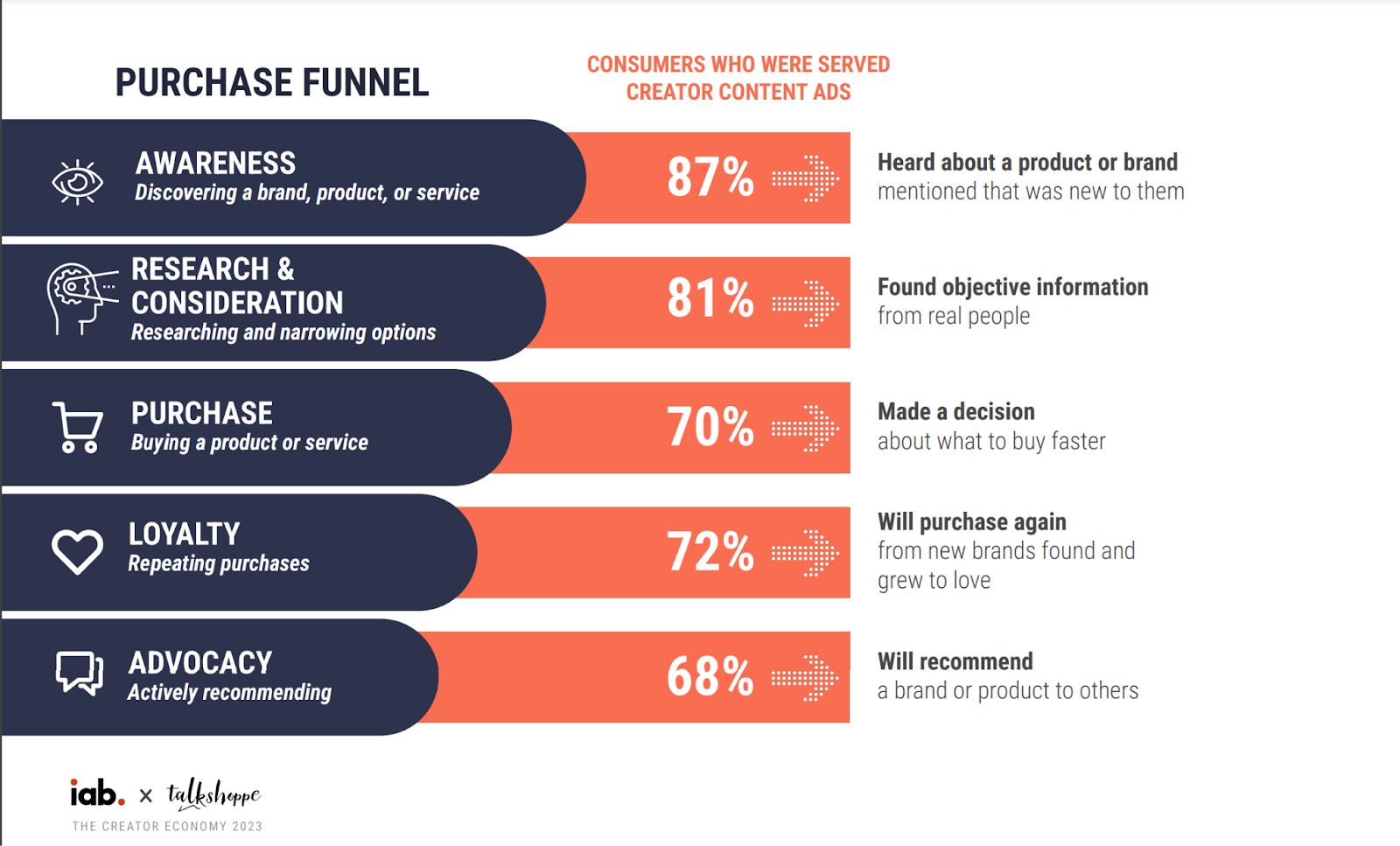
In the US, over 33% (over 50% of Gen Zs and millennials) said content creators influenced their buying decisions.
As a result, affiliate marketing was estimated to be worth more than $14 billion. Additionally, in 2023, affiliate link creation increased by 60%, while monthly clicks doubled between 2022 and 2023.
In 2023, 50% of consumers said they had tipped a creator14.
41% tipped $5-$10, up from 17% in 2021. Additionally:
- 24% tipped $10-$20, up from 19% in 2021.
- 10% tipped $20-$50, down from 14% in 2021.
- 5% tipped over $50.
More mature creators (over 500,000 followers) prioritized engagement, with over 51% of creators consistently engaging their followers.
This was also the case for:
- 43% of creators with 75,000-499,000 followers
- 40% of creators with less than 10,000 followers
- 37% of creators with 10,000-74,999 followers
81% of content creators acknowledged the role of music in increasing engagement levels and keeping up with pop culture trends.
In addition, 76% of creators felt that music was pivotal to how much income they generated from their content.
Further:
- 85% of creators selected music for their content based on how they wanted their audience to feel.
- 84% of creators felt that the right music helped attract more viewers.
- 84% agreed that music was important for fostering deeper connections.
In both 2021(29%) and 2023 (26%), YouTube was consumers’ favorite platform for tipping and subscribing to support their favorite creators.
This was followed by TikTok (20%), Twitch (14%) and Instagram(13%).
The key reason consumers tipped a creator was to show support (35%).
Other reasons included wanting to interact (17%) and enjoying niche content (14%).
62% of creators cited that specializing was helpful for engagement and reach.
Of the channels that creators used to generate revenue, having a niche had a greater impact on monetization across the board.
The media and entertainment niche proved to be the most lucrative for creators, earning them over $2000 for all post types.
Instagram Reels and TikTok videos were most profitable at over $500 per post for content creators in the Cosmetics and Fragrance industry as well as the Fashion Industry.
Additionally:
- 50% of creators in both Food and Beverage charged $5,000 for Instagram posts and Reels.
- 50% of creators in Lifestyle and Interior Design charged over $500 per post for Instagram Reels and TikTok videos.
Creator economy marketing statistics
As of 2024, close to 50% of advertisers reported consistently allocating their budgets toward creator content marketing.
Additionally, 44% of advertisers planned to increase their investment in creator content by an average of 25% in 2024.
89% of advertisers felt positive about creator content advertising.
Over 90% of advertisers saw it as a high-quality channel while 86% considered it easy to move ad budgets to creator content.
86% of advertisers felt confident in their ability to measure the effectiveness of creator content campaigns.
Nearly 90% of advertisers used trusted KPI metrics across content types, inspiring their confidence and encouraging repeat media buys.
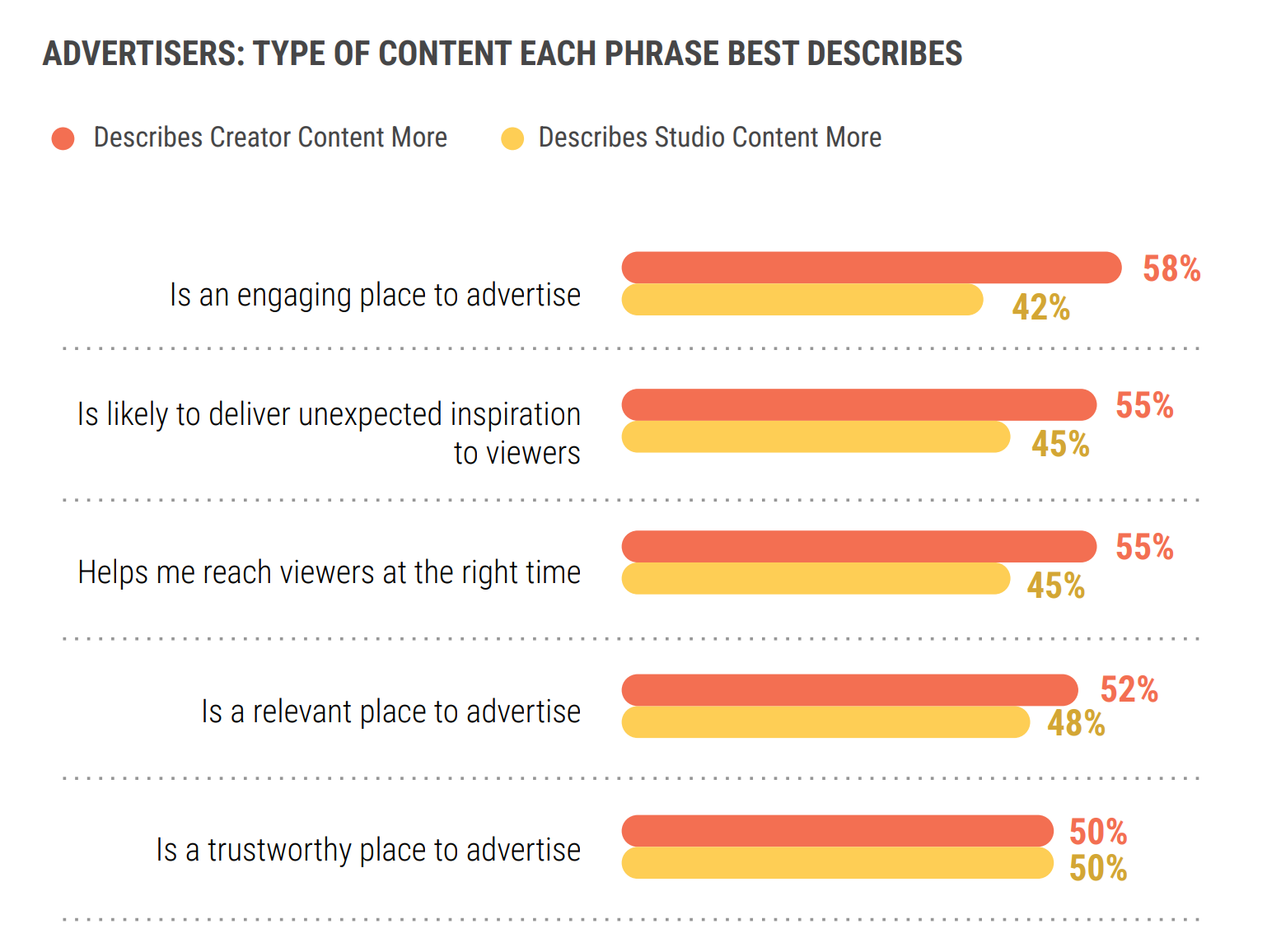
When asked about creator content, 58% said it was a more engaging way to advertise.
Additionally, compared to traditional studio content:
- 55% of advertisers considered creator content more likely to inspire consumers.
- 55% of advertisers considered creator content helpful for reaching views.
- 52% of advertisers considered creator content more relevant.
- 50% of advertisers considered creator content more trustworthy.
44% of creators reported an increase in brand collaboration offers in 2023 compared to 2022.
Additionally, 40% of creators said they’d received more opportunities since 2022, while 43% of creators made more money compared to 2022.
Creator economy platform statistics
Email was considered the best platform for engagement in 2024 by 27% of creators, followed by Instagram (15%).
Other top engagement platforms were:
- Facebook - 12%
- Blog posts - 11%
- LinkedIn - 8%
- YouTube - 8%
Over 50% of top earners stated that social media platforms were essential for their business as they allowed them to directly engage with their audience and build community15.
The top channels for lead generation were Instagram (22%), YouTube (21%) and TikTok (19%), whereas the top channels for building community were YouTube (22%), TikTok (22%) and Facebook (18%).
Creators drove between 60% to 90% of all video views on the largest social platforms16.
Notably, in 2024 creators and their content were responsible for:
- 92% of all video views on YouTube.
- 91% of all video views on TikTok.
- 83% of all video views on Instagram.
- 60% of all video views on Facebook.
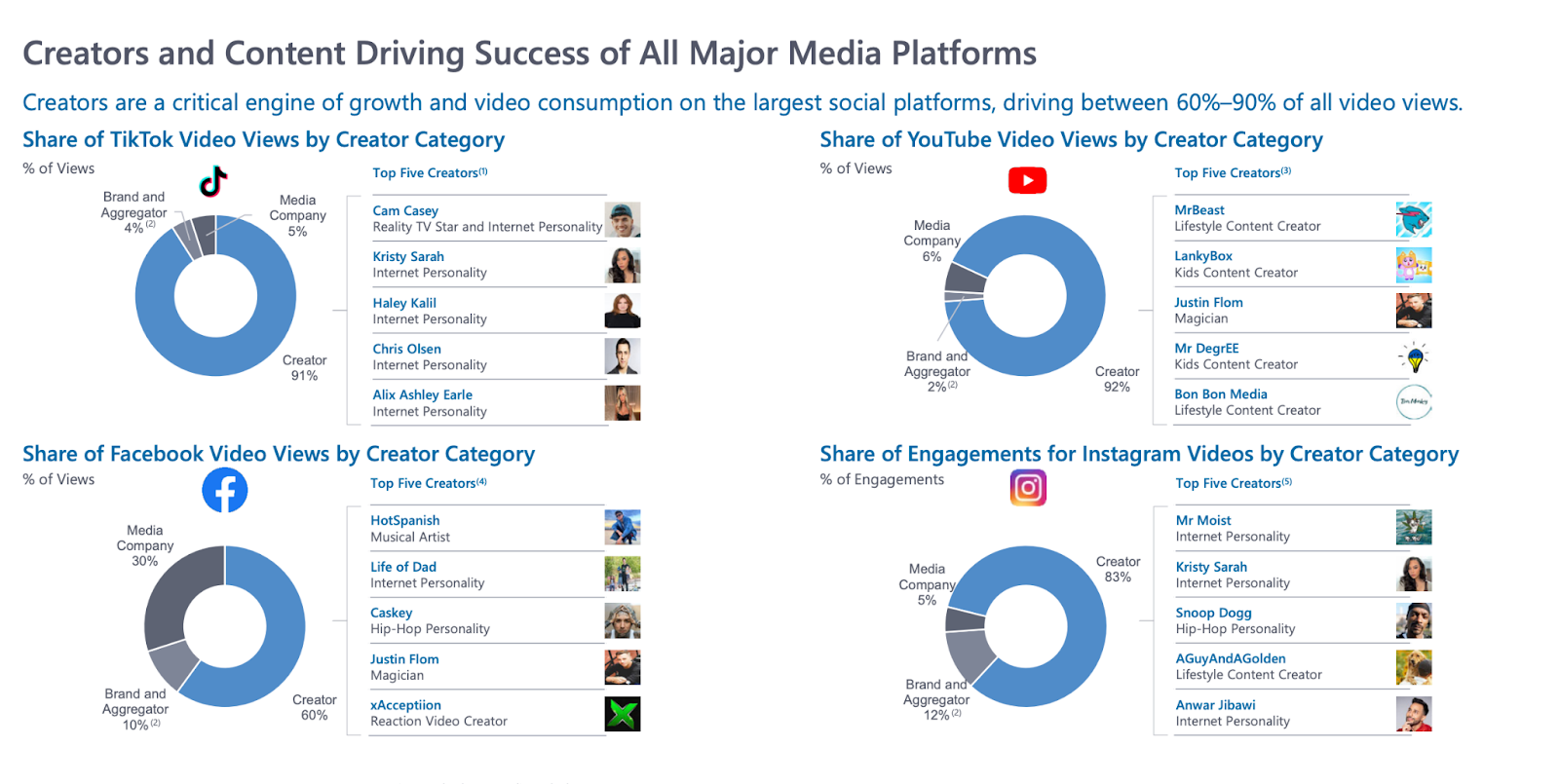
Between 2019 and 2024, creator economy company Linktree reported that it had hit over 50 million17 users.
- Linktrees were viewed more than 3x a month per visitor on average.
- The most popular Linktrees got traffic from an average of 12 sources and the top 3 link drivers were social platforms Instagram, TikTok, and Twitter (X).
- 25% of the links created on Linktree since the start of 2022 came from YouTube, TikTok, and Instagram.
Creator links to TikTok increased by 300% between 2022 and 2023, while links to Eventbrite increased by 200% during the same period.
- Links to LinkedIn increased by 42%.
- Links to Google Docs increased by 27%.
- Links to Spotify links increased by 23%.
50% of creators on Linktree made money from their content between 2022 and 2023. In fact, their average monthly revenue increased by more than 25%.
- 72% of creators made less than $500.
- 17% of creators made between $500 and $5000.
- 5% of creators made between $5000 and $10,000.
- 4% of creators made between $10,000 and $50,000.
- 2% of creators made over $50,000.
85% of creators used tools like priority links to capture attention and drive engagement.
Animated links drove click-through rates higher by more than 85% compared to static links.
Links to Shopify and Spring link apps increased by 58% and drove more than 38 million clicks.
Between 2022 and 2023, average monthly clicks from Linktree increased by:
The most important platform elements for creators were content management systems that were easy to use (52%), followed by networking opportunities (49%).
Other key elements included:
- Performance management and analytics capabilities - 45%
- Predictable/ understandable algorithm for content visibility - 42%
- Practical content editing tools - 39%
Creators depended on YouTube the most compared to other social platforms. In fact, 42% of creators would lose over $50,000 per year if they lost access to the platform.
- 38% of creators would lose over $50,000 per year if they lost access to Instagram.
- 37% of creators would lose over $50,000 per year if they lost access to TikTok.
- 36% of creators would lose over $50,000 per year if they lost access to Facebook.
YouTube’s creative ecosystem contributed more than $35 billion to the US economy in 2022 and supported more than 390,000 full-time equivalent jobs19.
Meanwhile, activity on TikTok contributed $24.2 billion to the GDP in the US in 2023, while supporting 224,000 jobs.
77% of monetizing creators felt fairly compensated by platform monetization programs.
28.6% of creators cited YouTube as their top income source, followed by TikTok (18.3%) and Facebook (16.5%).
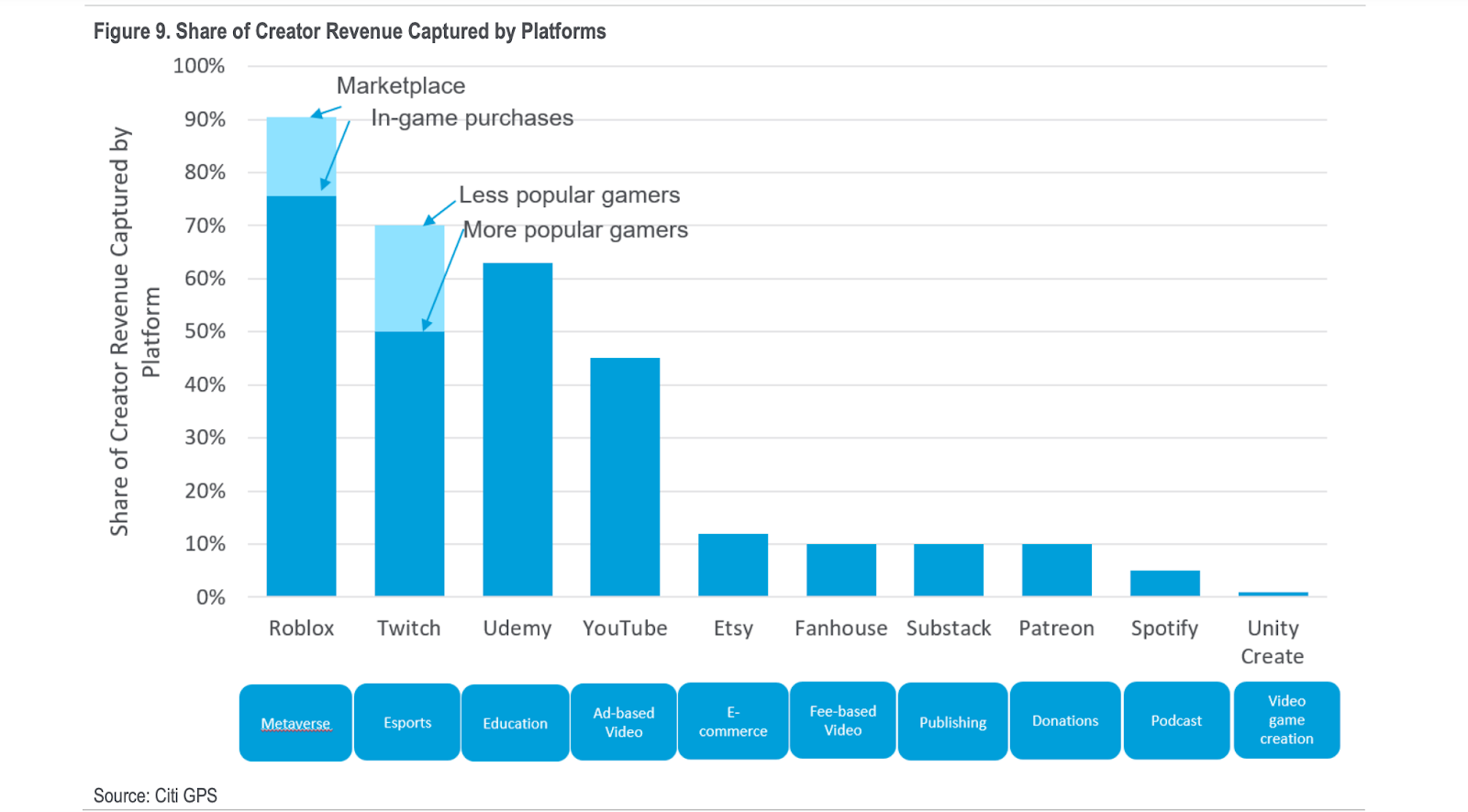
As of 2024, creator platforms collected anywhere between 10% to 90% of creators' revenue. For example, Roblox collected 75% to 90% while Spotify and Etsy collected less than 10% of the creator’s revenue.
Breaking this down, CITI research found that platforms that:
- Promoted content collected 33% of creators' revenues.
- Hosted content collected up to 19% of revenues.
- Helped with monetization collected up to 11% of revenues.
- Helped with content creation collected 7%.
- Helped with distribution collected up to 6%.
Net creator revenue per year by platform was highest on Substack at $25,000 per year and Patreon at $6,000 per year.
This was followed by:
- Udemy - $3,300
- Etsy - $2,700
- Twitch - $530
Creator economy monetization statistics
Monetization in the creator economy has five potential sources, namely:
- Advertising
- Subscriptions
- Donations
- Purchases
- Sponsorships
Around 4% of global creators were professionals earning an income of over $100,000 a year, down from 10% in 2022.
- A majority (37%) of creators made between $5000 and $30,000, down from 36% in 2022.
- 34% of creators made less than $5000, up from 32% in 2022.
- 20% of creators made between $30,000 and $100,000 down from 22% in 2022.
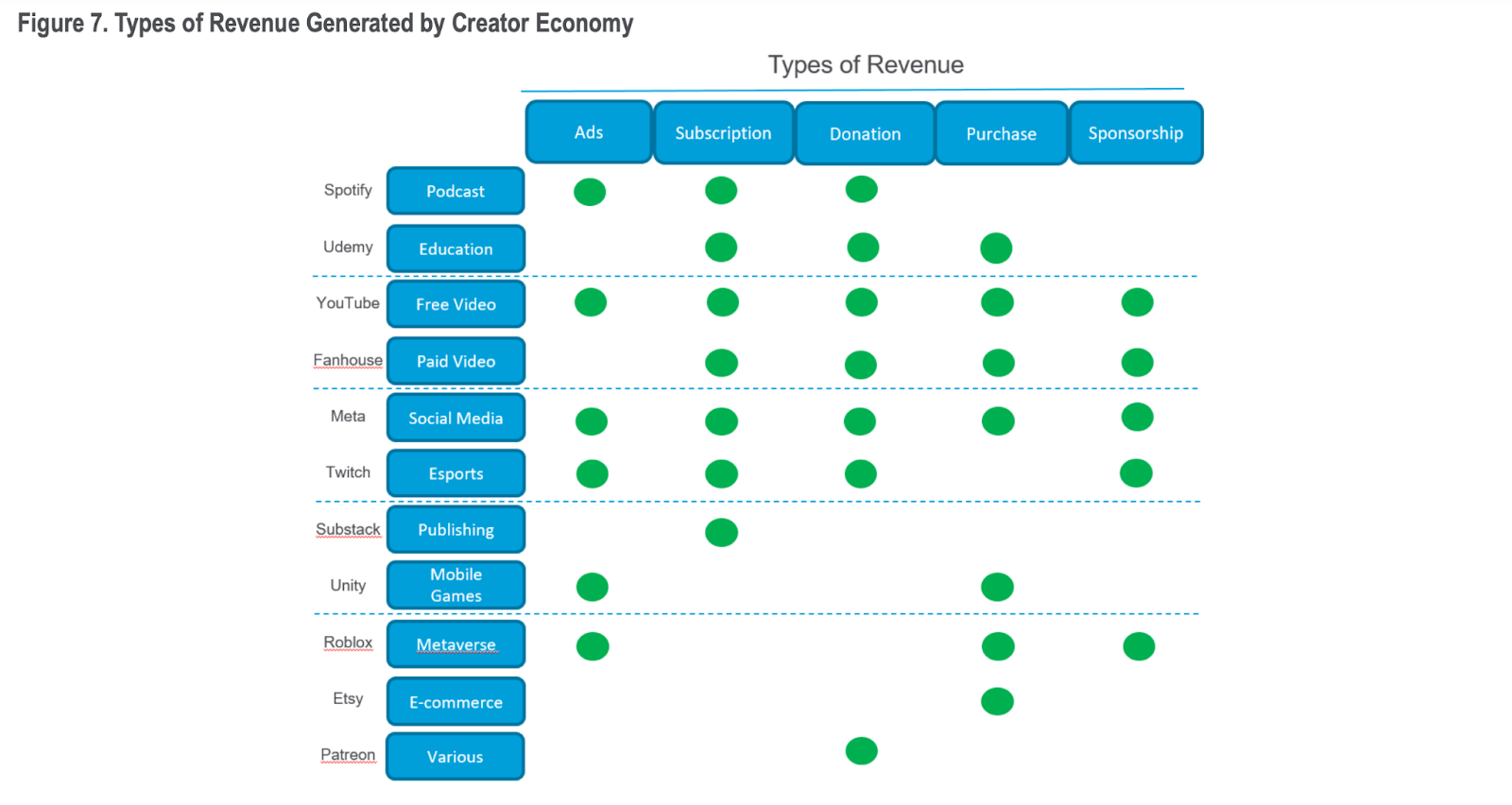
Brand deals accounted for 70% of creator revenue in 2023. Meanwhile, ad share, own brands, affiliate links, and tips all accounted for less than 5% of creator income.
Creators in the US alone made over $8 billion from sponsored content in 2024, up from $5 billion in 202121.
- Platform payouts amounted to $3.23 billion in 2024, up from $2.34 billion in 2021.
- Creators made $1.1 billion from affiliate marketing in 2024, up from $570 million in 2021.
On average, it took creators around 6 months to start generating revenue, with most creators reporting that they needed to make over $75,000 annually to meet their needs.
Meanwhile, it took 18.4 months for creators to fully support themselves, and 18.8 months to hire help for the first time.
Content creators generated revenue from 2 to 3 sources with the most common being sponsored content (82%).
This was followed by affiliate income (56%) and advertising (33%).
A majority of creators made less than $500 per month, while 32% made less than $250 per month, and 25% made over $2,000 per month.
Additionally:
- Part-time creators were more likely to make less than $500 per month, while full-time creators were more likely to make $2,000-$4000 per month.
- Creators with less than 15,000 followers were more likely to make less than $250 per month, while creators with over 250,000 followers were more likely to make $6,000 to $10,000 per month.
- Creators in the cosmetic industry were more likely to make less than $250 per month compared to other top industries like lifestyle, travel, fitness, or fashion.
- Creators aged 18-24 years old were more likely to make less than $250 per month compared to older creators.
55% of monetizing creators identified as full-time creators in 2024, signaling a 3% increase from 2023.
- Over 81% also worked on their personal brands in the past year.
- 49% spent 20 hours or more per week on content creation.
- 39% had been producing content for 2-5 years.
The top monetization method used by 50% of creators was live streaming.
- 48.3% of creators used ad-revenue share programs.
- 44% used brand sponsorships, down 14% from 2023.
- 42.6% used paid subscriptions.
- 39.3% used affiliate marketing.
Generally, higher income was associated with higher satisfaction levels. Creators earning over $250,000 had the highest satisfaction score at 7.9, followed by creators earning $100,000 - $250,000 with a score of 7.6.
On the other hand, creators making no money and those making under $10,000 had satisfaction scores of 5.3 and 6.5 respectively.
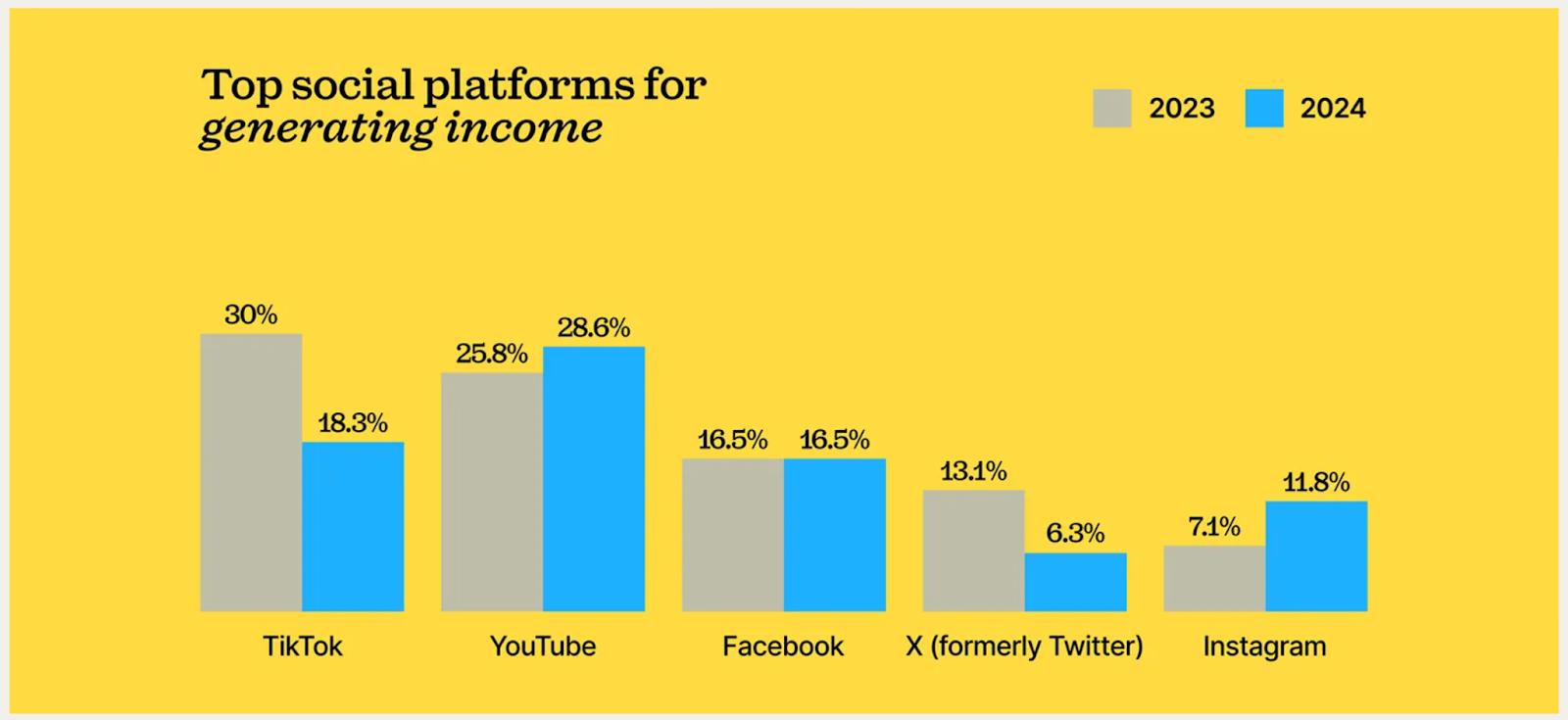
49% of creators stated that their rates had increased since 2022.
Instagram Reels and Instagram Live were the most likely to command high rates with over 40% of creators charging $500+ for these posts. Rates for Facebook posts and Instagram Stories were generally less than $250.
82% of creators with less than 5,000 followers charged rates below $250, while 54% of creators with 5,000 to 15,000 followers cited the same rates.
Meanwhile, over 50% of creators with 100,000 followers charged rates of over $1000 for an Instagram post.
The top revenue streams for high-earning creators were:
- Digital products
- Platform payouts
- Physical products
- In-person consulting and coaching
- Online Consulting and coaching
The number of creators finding new ways to monetize increased in 2024, with 75% of top-earning creators stating that multiple revenue streams were crucial to financial success.
- In fact, top earning creators making over $150,000 or more per year had over 7 revenue streams.
- Creators who earned between $100,000 and $150,000 had around 5 revenue streams.
- Creators who earned under $100,000 had 2 revenue streams.
Creator economy and AI statistics
84% of creators leveraged AI-powered tools and applications in their content creation process in 2024.
The top AI tools used by creators in 2024 included:
- Image or video recognition software - 47%
- Automated transcription tools - 33%
- Chatbots or virtual assistants - 32%
- Personalized recommendation engines - 32%
The creators who used AI most were marketers (76%), YouTubers (75%) and entrepreneurs (72%).
Meanwhile, the creators who used AI the least were artists (52%) and authors (53%).
While AI solution adoption saw a slight decline in 2024, over 50% of creators still appreciated AI tools for their ability to boost productivity and save time.
43% of creators valued their ability to reduce costs.
41% of creators used AI to generate written content, while 23% used AI for editing purposes.
Other key uses included Marketing (12%), generating graphics content (7%), and scheduling and organization (7%).
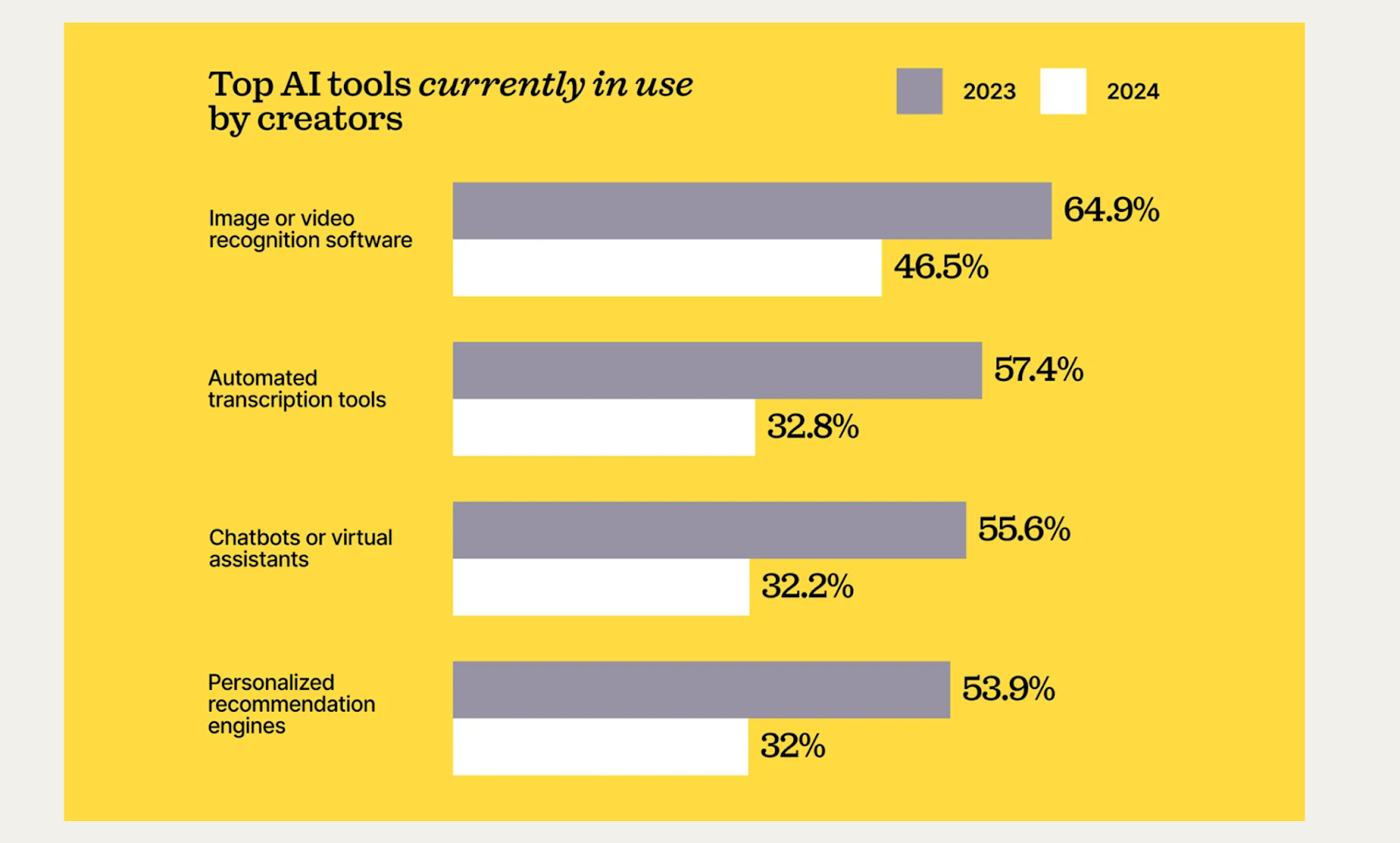
In terms of AI content creation, 49% of creators expressed concern about the quality of AI-generated content.
- 39% worried about the lack of originality.
- 33% were apprehensive about plagiarism.
- 29% had reservations about the ethical implications of AI for content creation.
Six-figure creators used AI twice as often as other creators in 2024 with 43% of creators leveraging AI tools weekly.
29% of creators used AI daily, while 14% used AI monthly. On the other hand, 4% tried AI tools and never tried them again and 3% had never used AI.
81% of creators reported more favorable consumer engagement on their Generative AI content in 202422.
Generative AI content stood out in feeds, lasted longer, generated wider reach, and achieved 2-5x more engagements.
75% of marketers and 69% of creators believed that AI would positively disrupt the creator economy.
35% of creators agreed that AI would increase the diversity and quality of their creative assets.
75% of marketers increased their spending on Generative AI creator content in 2023.
A growing number (65%) were willing to pay more for creator content designed using generative AI. A further 70% planned to increase their spending in 2024.
82% of creators believed AI would accelerate content creation, 79% believed it would reduce their workload and 78% felt confident generative AI would increase their earnings.
However, 87% of creators expressed the need for more AI regulation in the creator economy. This was echoed by 90% of consumers and 87% of marketers.
All age demographics tended to have a more positive than negative response toward AI in the creator economy, with men more likely (64%) than women to prefer generative AI creator content over traditional content.
- Men were also more likely to rate the quantity, quality, and diversity of generative AI creator content higher compared to women.
- Men also tended to view creators who use generative AI more favorably, with 32% expressing positive views compared to 26% of women.
- They were also more likely to perceive brands and products (30%) in a positive light when promoted using generative AI creator content compared to women (24%)
Creator economy challenges
75% of creators planned to diversify their content in 2024.
However, they also felt pressure to keep making what was rewarded by platform algorithms.
43% of creators stated that balancing content creation with monetization was a key challenge.
This was followed by marketing and making sales (36%) and understanding what audiences were prepared to pay for (34%).
46% of creators stated that it was challenging to be successful in the creator economy.
A further 41% said they struggled with burnout.
58% of creators said they faced challenges monetizing their content in 2024, down from 62% in 2023.
Other monetization challenges included:
- Limited audience and reach - 54%
- Inconsistent income - 45%
- Difficulty finding brand partners - 39%
- Platform algorithm changes - 38%
The key challenges creators faced when doing brand collaborations included:
- Lack of communication and clear expectations - 48%
- Micromanaging, restrictive creative control - 38%
- Being misunderstood - 37%
- Poor compensation - 37%
- Lack of transparency and fair negotiation - 33%
For creators incorporating music into their content, over 50% cited having encountered content removal, muting and demonetization due to copyright issues.
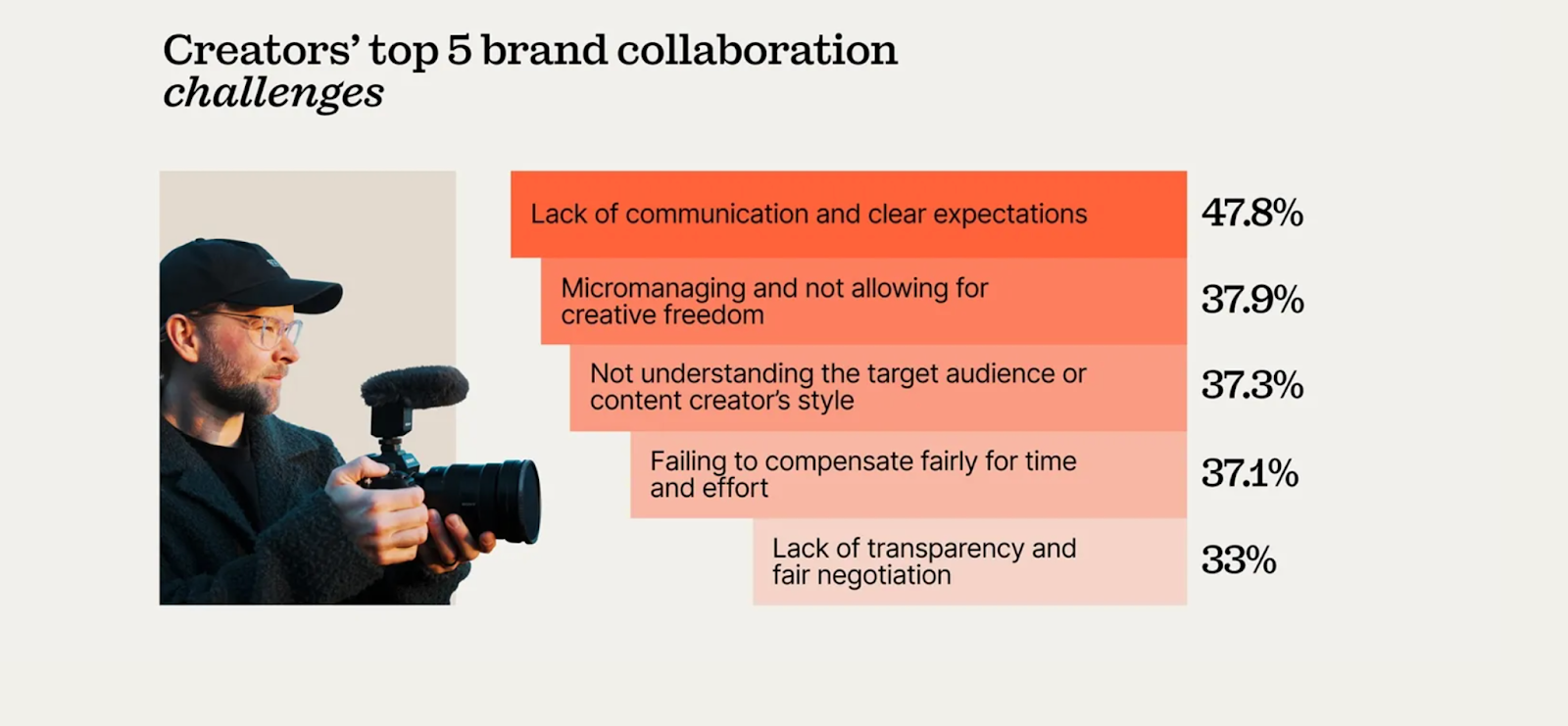
65% of creators expressed worry that a potential TikTok ban would have a negative impact on their income.
In light of the possible impact:
- 49% of creators increased their presence on other platforms, while 21% planned to do so.
- 67% of creators also planned to generate fresh platform-specific content, while 41% planned to repurpose their existing TikTok content for other platforms.
- 38% of creators were optimistic that other platforms could offer similar opportunities, while 15% were doubtful about other platforms being able to match TikTok’s impact.
The key content challenges creators faced included:
- Ensuring the discoverability of their content.
- Monetizing their content.
- Creating regularly.
68% of creators weren't satisfied with how much money they made.
However, 96% didn't regret joining the creator economy.
The top 3 challenges top earning creators worried about in 2024 were:
- Impacts from inflation - 36%
- Platform volatility (algorithm changes and account banning) - 34%
- Growing their audience - 32%
For those intending to become creators, not knowing where to start (45%) and time constraints (41%) were key challenges.
Other challenges included fear of failure (40%) and not feeling qualified enough (32%).
Future of the creator economy statistics
The number of global creators is expected to grow at a 10-20% compound annual growth rate by 2028. As millions compete for their share of the market, creators are unifying their online offerings and exploring ways to own their audiences.
Notably:
- 75% of creators who have a membership community are monetizing it.
- 88% of creators are leveraging their own websites.
- 24% of creators are using Linktrees for greater visibility.
- 15% have a private social media channel.
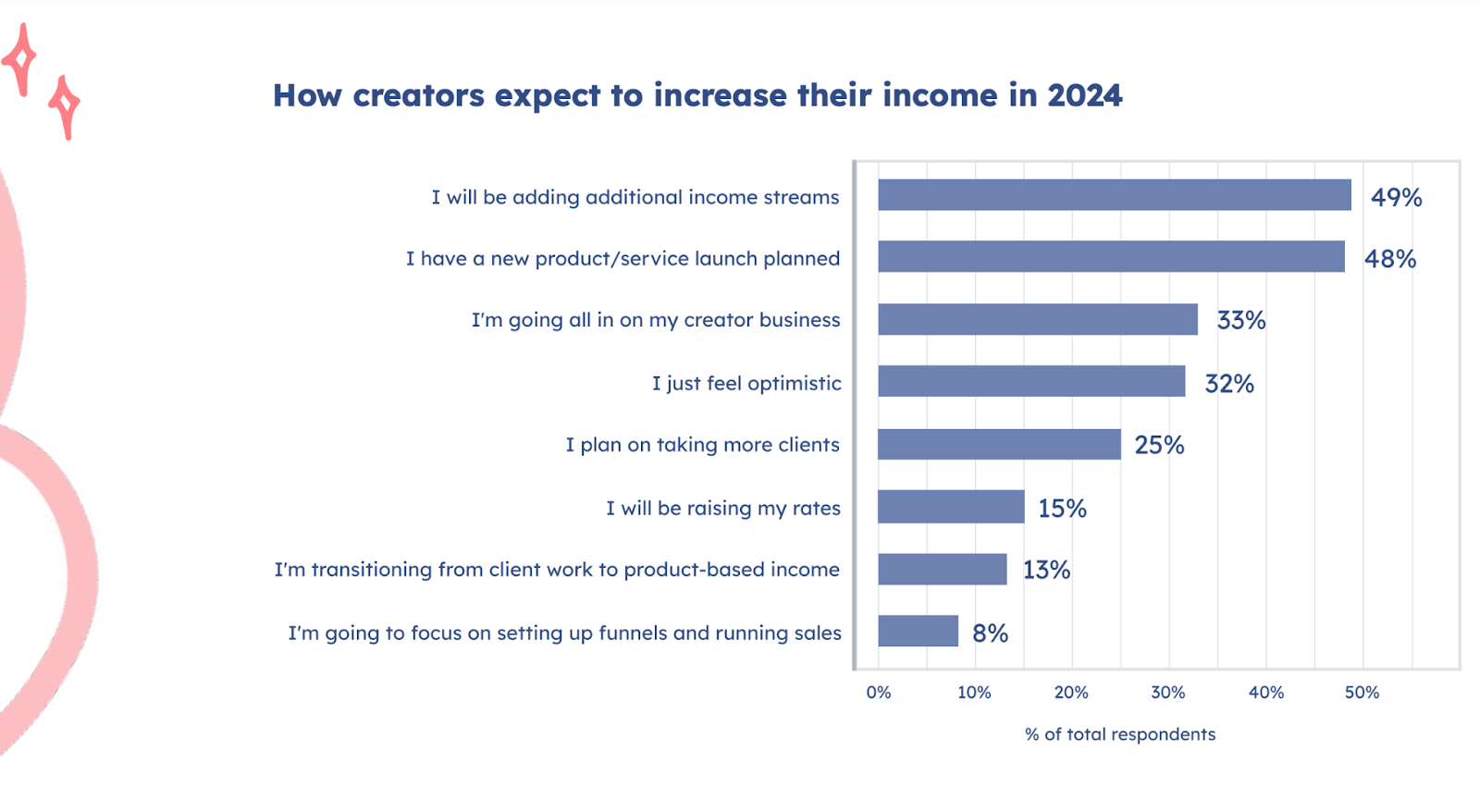
88% of creators expect to make more in 2024 than they did in 2023.
49% plan to do this by adding additional income streams while 48% have a new product/service or launch planned.
Key engagement priorities for creators in 2024 include:
- Audience growth - 18%
- Relationship building - 11%
- Automation - 8%
- Expanding into a new platform - 4%
73% of top-earning creators believe AI tools will help save over 26 hours a week in 2024.
56% believe AI tools will be among the best ways to reduce burnout in 2024.
Beyond 2024:
- 30% of creators plan on diversifying their revenue streams.
- 30% plan on launching a successful new product or service.
- 28% plan on investing in a newsletter, up 8% from last year.
- 27% plan on creating an exclusive membership, up from 5% last year.
- 20% plan on building an email list.
By 2027, revenue generated in the creator economy is estimated to double to $480 billion.
- Driving the creator economy is digital content creation, which is expected to surpass $100 billion by 2030.
- Video content, prized for its high engagement and conversion rates is expected to fuel this boom.
Join Whop and become a part of the creator economy
Whop is at the forefront of the creator economy, helping thousands of creators meet millions of customers with it's social commerce platform.
With Whop you sign up and create your own whop - which is your online hub. Your whop can be a storefront for your digital products and services, or it can also be a space for your community to communicate in private. With Whop you can sell:
- Access to your own private community
- Online courses and ebooks
- Digital downloads like templates and graphics
- Exclusive content like as videos, podcasts, blog posts
- Software
- Video calls in any form, such as online coaching calls, webinars, masterminds
Basically if it's digital, you can sell it (or access to it) with Whop. Whop understands what you need as a content creator and helps you every step of the way, by taking care of payment processing, allowing you to set up pricing tiers and sell memberships, managing your members and subscriptions, and automating the mundane processes that you would otherwise have to do yourself. Whop looks after the details so that you can focus on growing your brand.
Many creators on Whop make over $2000 a month, with some creators earning over $250,000 per month. There is no cap on your earnings, and Whop only makes money when you make money.
Sources



